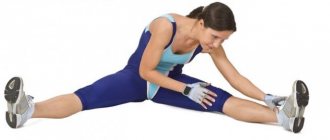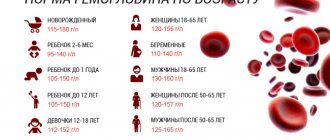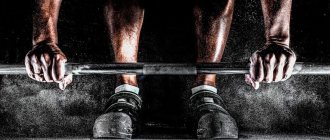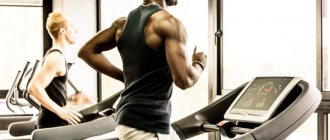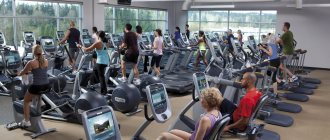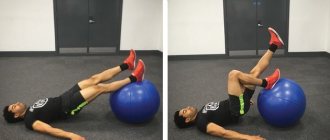Super series (superset)[edit | edit code]
What is a superset?
Yuzhakov Anton Superset. Watch from 6:18
Superset (super series)
- sequential performance of two (or more) different exercises without rest between them. There are two types of supersets that have fundamental differences:
1. Superset for one muscle group
involves combining two different exercises designed to work the same muscle group. The first exercise is a heavy basic exercise (about 80-90% RM), and the second is an isolation exercise (complementary exercise, 50-70% RM). The first exercise is aimed at activating all motor units (strength training and microtraumatization, developing strength endurance). The second exercise is aimed at acidification and pumping, to train fast oxidative muscle fibers. The effect is similar to Drop sets.
An example is a super series for developing and increasing the strength of the pectoral muscles:
- bench press on an inclined board (at an angle of 30-40°), weight - 70% of the maximum;
- push-ups to the limit on parallel bars with a load suspended on a belt, the weight of which is equal to 10-15% of body weight.
2. Superset on antagonist muscles
- two exercises for antagonist muscles are combined in a pair and performed one after the other without rest. This approach aims to:
- development of anaerobic endurance
(lactic anaerobic capacity, adaptation to work in conditions of sudden acidotic changes), fat burning and training of the cardiovascular system with a large number of repetitions (10-20 or more for each exercise). You can work with failure after each approach. with long (up to 5 minutes) rest intervals (during which it is necessary to perform relaxation exercises, flexibility, various swings), the work will be aimed primarily at improving anaerobic glycolytic performance (glycolytic muscle power) - at relatively short intervals (less than 1 minute), the work is aimed at depleting anaerobic intramuscular resources and improving their capacity (lactate endurance).
(for reps of 8 and below, relatively heavy weights).
- To train alactic power, short bursts of explosive repetitions are performed. At the same time, you should NOT immediately bring one muscle group to fatigue, so the rest periods between supersets are longer (1-2 minutes), so that failure occurs only at the end of all approaches.
Joe Weider popularized this concept and emphasized the word “antagonists” to further emphasize that the two exercises in a superset should be opposite in nature. For example, bench press for the chest and row for the back, or triceps extensions and biceps curls.
The beauty of these supersets is that they allow you to train two body parts with the same amount of rest as a regular sequential set. Thus, supersets make it possible to increase the volume of load in a limited period of time and do not force you to sacrifice strength and power. In fact, supersets can even increase explosive power and endurance.
Efficiency research[edit | edit code]
In 2009, the Journal of Sports Science published a study that demonstrated the effectiveness of superset training. Over the course of 8 weeks, a group of athletes performing supersets of bench presses and incline rows—the opposite pulling movement for the upper back—made measurable gains in both their bench press and deadlift. For comparison, in the group of athletes performing “regular sets,” only an increase in peak bench press strength was noted. The superset technique has proven to be less time-consuming and more effective in increasing one-rep max.
These findings support an experiment published back in 2005 in the Journal of Strength and Conditioning. Rugby players with good experience in strength training performed bench presses. Athletes who did the bench press as part of supersets outperformed guys who only did the bench press in terms of strength gains by 4.7%.
Conclusion.
Science says you save time, get more work done, and get much stronger when you train with supersets.
How to do it correctly?
As mentioned above, supersets are needed to train antagonist muscles. Antagonists are muscle groups that create opposite effects in relation to each other, that is, flexor muscles and extensor muscles of the joints. For example, quadriceps + hamstrings, pectoral + latissimus dorsi, biceps + triceps, anterior + posterior deltoids.
By the way, there is a common myth that you should not train the top and bottom on the same day, they say, “there won’t be enough blood.” This, of course, is nonsense: Training program in the gym: is it possible to train arms and legs in one day? .
How to do superset workouts? Muscle failure in both complex and supersets must be achieved only in the last approach . It is most effective to use supersets to train small muscle groups, such as the arms and shoulders. If you train large muscle groups with supersets, then it is better to use isolation exercises. The fact is that a lot of energy is spent on basic exercises for large muscle groups, in addition, since many different muscles are involved in basic exercises, some of them will be stressed in both exercises, and this will limit your capabilities.
Perform the exercise on the lagging muscle group first in the superset in order to load it more efficiently.
Tempo[edit | edit code]
- maximum
. It is used either with minimal or no burden at all. As a rule, it is used to reduce weight or develop more pronounced muscle definition;
- fast
. Slightly inferior in speed to the maximum. It is used when you need to develop speed-strength capabilities with medium or heavy weights.
To develop special endurance, the weight of the burden is reduced to small, and the frequency of movements is raised to 80-90% of the maximum pace.
If an athlete with a barbell weight of 50% in the bench press does 22-24 lifts at a maximum pace in 20-25 seconds, then at a fast pace in the same time he manages to do 18-20 lifts.
It must be remembered that maximum speed sometimes comes at the expense of the accuracy of the exercise, as a result of which a decrease in the effectiveness of strength development may be observed. Therefore, when using high speeds, it is necessary to systematically monitor your achievements by performing exercises for a while (for example, recording the number of squats or push-ups on uneven bars in 30 seconds);
- average
. This is the optimal speed for performing exercises for most athletes. When used, muscle tension alternates with relaxation, which has a beneficial effect on the internal organs.
The resistance level for exercises at an average pace is usually 70-80% of the maximum. With excellent physical fitness, you can use more weight.
With a weight less than 70% of the maximum, exercises at an average pace may be ineffective;
- slow
. The exercises are performed at this pace in the following cases. If he gives better results in certain exercises (in the overhead barbell press with elbows fixed, in training the hands, etc.) or if the exercise cannot be performed at either a fast or an average pace (for example, due to risk of muscle damage), as well as when it is necessary to activate large muscle groups.
Performing exercises at a slow pace does not allow the athlete to use the inertia of the movement of the projectile; due to constant muscle tension, the effectiveness of the training increases.
A slow pace pairs well with isometric exercises. For example, lifting the barbell the first 2-3 times at a slow pace, the athlete holds the apparatus at the dead point of its lifting for 3-5 seconds, after which he performs another 2-3 lifts (again at a slow pace).
It must be said that in practice only one or another tempo of movement is never used. Most often there is an optimal combination of tempos.
Slow tempo is usually combined with medium and fast. For example, the athlete performs the first 3-4 sets at a fast pace, the next 3-4 at an average pace, and the last 2-3 repetitions at a slow pace.
conclusions
Both women and men can use supersets, the main disadvantage is the minimal increase in strength, since it requires a lot of effort and the average weight is taken, the main goal is to increase mass and burn fat.
You need to use a superset, not immediately, but after 3 months of stable training, so that the body becomes stronger physically.
If you do not take this drawback, then the superset is a powerful tool for building a sculpted athletic figure, as well as a way to diversify exercises without making them boring, and to waste less time, which is always lacking.
In general, guys, train and be big, and girls, slim and beautiful!
Rest[edit | edit code]
The superset technique involves sequentially performing these exercises without rest (although some authors allow a short rest of 10-20 seconds). After a short break (1-4 minutes), a new super series follows.
The duration of rest between supersets is easiest and most convenient to regulate using your heart rate. Before starting the exercise, it is usually 80-85 beats per minute. This is the so-called background heart rate level. After 4-5 approaches it can increase to 130-140 beats per minute. Before the next exercise or new superset, it is necessary to return the heart rate to its original state (background level), which usually takes 3-4 minutes. The following pattern must be taken into account: the higher the load, the more time a bodybuilder needs to recover between series.
Some of the more difficult exercises to perform (squats, bench presses, deadlifts) require a longer rest at first (sometimes up to 5 minutes). But over time, the heart rate will return to its original value much faster. In this case, the rest time can be reduced.
The duration of rest also depends on the goals that the athlete sets for himself. Losing excess weight requires significantly less rest between sets than developing strength and muscle mass.
It is recommended to alternate high-intensity activities with moderate and low-intensity work. Experienced bodybuilders, after a period of active training, sometimes take a week's rest, reducing the volume and intensity of training. During this time, they can engage in other sports (without lifting weights).
Advantages and disadvantages
The main advantages of supersets include:
- A boost to new muscle growth
Highly effective if you need to shake up muscles that are accustomed to monotonous loads.
- Reducing training time
Thanks to double sets, half the time is spent on the same amount of work.
- High energy consumption
Due to this, they are very effective when training for relief.
- Good pump
The muscles are pumped with blood, which makes them look more impressive during and after training.
Flaws:
- Difficulty in organization
In a crowded gym, it is difficult to practice using this method, since you need to always have two free exercise machines.
- The technique is not for everyone
Not suitable for beginners. Intermediate and advanced levels will benefit the most.
- High risk of overtraining and development of stagnation
Supersets are an intense load. If you practice this method for a long time, it can lead to exhaustion of the body and a complete stop in the growth of results.
Supersets for the chest[edit | edit code]
For muscles to grow, they need to be shocked, “surprised.” This is possible with the help of classical exercises for antagonist muscles, but also to an even greater extent, for one individual muscle. For example, supersets for the chest muscles could look like this:
- Dumbbell bench press – 10x3
- Lying dumbbell fly - 10x3
If you have squeezed out a certain number of times and are no longer able to do so, this does not mean that your muscles are no longer capable of anything. Even if you pressed dumbbells weighing 40 kg 10 times, you can easily master the lift of 16 kg dumbbells for another 10 repetitions. The principle of a superset for one part of the body is based on this understanding. It is clear that the intensity of the workout becomes prohibitive, but believe me, it’s worth it!
It is characteristic that such supersets can load not only an entire muscle, but also a separate section of it. Still in the same dumbbell bench press, the pectoral muscles are fully involved (top, middle, bottom, internal areas, external). Wanting to further work the outer areas of the pectoral muscles, you perform dumbbell flyes after the presses, as shown above. If you are more interested in the internal parts of the pectoral muscles, dumbbell flyes can be replaced by bringing your arms together on blocks (crossovers) or bringing your arms together in a pekdek machine. You can also do it in such a way that both movements will mostly affect only a separate section of the muscle. For example, in chest training you want to change the emphasis of the load to the upper beams.
Causes of imbalance
There are 2 main reasons for the lag of the inner parts of the pectorals:
- Using monotonous training techniques
If you exercise for a long time according to the same pattern, certain areas of the muscle group do not receive the necessary load. Without taking them into account, it is impossible to build aesthetic breast proportions.
As a rule, for most amateur bodybuilders, the upper pectorals (clavicular area) and their inner part are knocked out of the overall picture.
If measures are not taken in time and the training load is not adjusted to the middle of the chest, the disproportion will only increase.
- Structural features
The second reason is not as common, but more difficult to correct. This is a congenital, genetic structure of the pectoral muscles, with a pronounced defect in the inner part of the chest.
Many years of bodybuilding experience show that regardless of the cause of the lag, the problem can be eliminated.
In the first case it is a matter of several months, in the second – several years.
Having established the cause of the imbalance, we move on to the practical section on how to pump up the inner part of the pectoral muscles.
Examples of supersets[edit | edit code]
Below are approximate supersets for one body part:
- Supersets for the back
: bent over barbell row - wide grip row of the upper block to the chest - Supersets for the chest
: bench press - dumbbell flyes lying upside down - Supersets for quadriceps
: leg press - leg extension in the simulator - Supersets for hamstrings
: barbell rows on straight legs – leg curls in a lying machine - Shoulder supersets
: seated dumbbell chest press – standing side dumbbell swings - Calf supersets
: standing calf raises - sitting calf raises - Abdominal supersets
: bending while standing at a block - lifting bent legs while lying on a bench
Separately, I would like to say about supersets for the deltoid muscles. The deltoids do not have antagonists, but in fact, these are different bundles of these muscles. Therefore, when you perform swings for the front bundles and then move on to the rear, consider that you are training different muscles, since the front muscles are not included in the work when training the back muscles, and vice versa. This should be taken into account.
I would also like to say something about rest breaks. There are no such exercises between approaches within the superset itself, but after you finish a double approach, you should rest for at least a minute to a minute and a half. I have heard of some athletes training with antagonist muscle supersets without stopping at all. But believe me, this is extremely difficult, so I would not recommend such experiments. The fact that you need to rest after each superset for one muscle is not even discussed.
And one more thing: you can complicate the task somewhat and instead of supersets, do trisets (structured approaches) or giant sets (when you do sets of four or more exercises without rest). It is clear that such methods are very difficult, and if they are used, it is usually to work the abdominal muscles, when additional weights are not used. Trisets can be started with an approach to the lagging muscle or its area and finished with it. For example:
- Bent-over barbell row – bench press of dumbbells – row of the upper block to the chest.
What is in training?
Let's figure out what this actually means. Supersets (super series) are one of the ways to create muscle stress, which is achieved by increasing the intensity of training and time under load. These are exercises for the whole body in a specific order. We want to especially draw attention to the fact that this is only one of the methods , and not everyone needs to use this method and not always.
Are supersets effective? Yes, they are effective! So, should you only use supersets? No ! In essence, this method of training is a combination of two or more exercises in one approach. In practice, 2 exercises are most often used: you perform a specified number of repetitions of one exercise, and then, without rest, another certain number of repetitions of another exercise.
Schematically it looks like this:
- Set of exercise #1 - Set of exercise #2 - Rest - Set of exercise #1 - Set of exercise #2 - Rest.
- Set of exercise #1 - Rest - Set of exercise #2 - Rest - Set of exercise #1 - Rest - Set of exercise #2 - Rest.
There is also an option with rest between exercises, when you perform one exercise, rest, and then do the following:
How to read supermarket labels correctly
Example of a training program[edit | edit code]
Workout 1
- Superset
Squats with barbell 3*8 - Leg bending in the simulator 3*8
- Barbell curl for biceps 3*8
- Alternating bending of arms with a dumbbell with supination of the hand 2*12
Workout 2
- Pull-ups with weight 3*8
- Bent-over barbell row 3*8
- Bleeding rear deltas 3*8
- Standing overhead barbell press 3*8
- Lifting dumbbells to the side (side delts) 3*8
- Shrugs with barbell 3*8
Workout 3
- Superset
Platform Press 3*8 - Deadlift on straight legs 3*8



